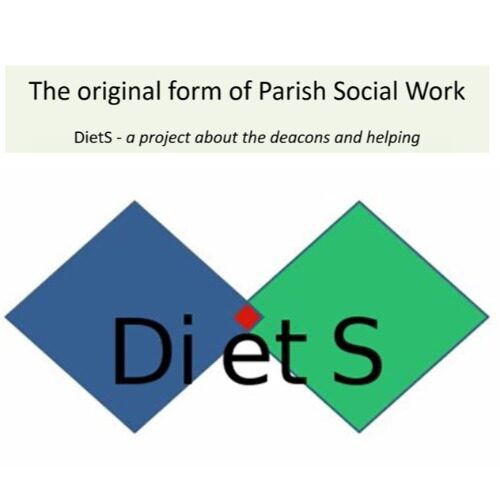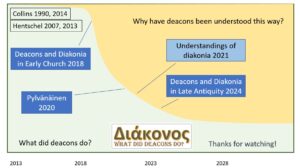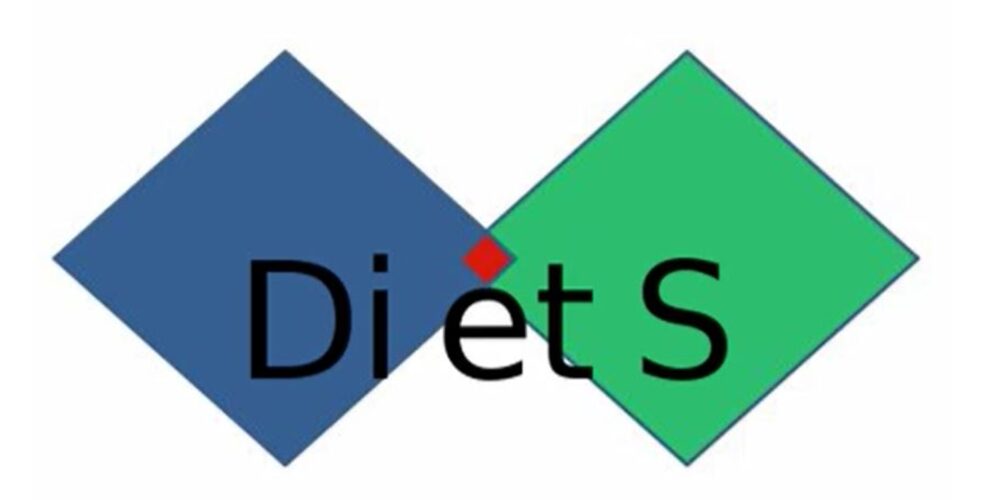
Leaders
The ”Diakonia and Parish Social Work” (DietS) project aims to collect, organize, and encourage the re-examination of ancient sources on diakonia from the 2nd to the 7th century, focusing on the accurate interpretation of roles and duties associated with diakonia and the correction of misinterpretations, extending to contemporary times. This endeavor facilitates opportunities for re-interpretations of diakonia, especially in ecumenical discussions regarding the ministry of deacons and deaconesses. The project promotes collaboration among researchers and underscores the importance of interpreting ancient sources in their original languages, thereby ensuring a comprehensive understanding of diakonia’s historical and evolving significance within the church.
We started in 2013. The starting situation is described in the following video.
The more specific description
The recent discourse on diakonia has been invigorated by the results of linguistic analyses conducted by scholars such as John N. Collins (1990, 2014) and Anni Hentschel (2006, 2013). Although we have gained an understanding of the lexical meanings of the diak-family, we have not yet fully applied this knowledge to the functions of parish life (Gooder 2006, Collins 2012b).
The objective of this meta-project is to compile and organize high-level scientific re-interpretations and to encourage a thorough re-examination of ancient sources related to diakonia (from the 2nd to the 7th century) in their original languages. In doing so, this project aims to uncover accurate interpretations of the roles and duties of deacons and the usage of the term ‘diakonia,’ as well as to rectify misinterpretations. This, in turn, creates opportunities for re-interpretations of diakonia, particularly in ecumenical discussions about the ministry of deacons and deaconesses. If there exists a one-sided or even distorted understanding of the tasks of deacons and the meaning of the term ‘diakonia’ across different centuries, it becomes challenging to achieve consensus on what a common vision of the role of deacons in the church should aim for. In the context of discussing diakonia, this project also analyzes the ministry and functions of a deacon/deaconess and the ways in which early Christians supported one another. Hence, the project is named “Diakonia and Parish Social Work.” (DietS).
The main way to fulfill this objective is to disseminate information (via internet pages, emails, meetings, etc.) and, in doing so, facilitate collaboration between researchers and other projects. This can also lead to new research projects about individuals or topics that have not yet been analyzed. Other methods may also emerge.
On this page, we will gather information about topics that use ancient sources in a similar manner or in ways that are cognizant of the approaches demonstrated by John N. Collins in his book. This page will not compile discussions about deacons and assistance but will instead focus on the interpretation and analysis of ancient source interpretations in their original language.
The main structure of DietS project
As the accompanying video shows, the initiative is divided into different time periods. Presented here are the most significant research materials suitable for each period, individual investigations already conducted (and fitting the initiative’s objectives), as well as undertakings carried out within this initiative (including studies by the initiative leader).
-
See the list of Literature about more information
2.0 New testament
2.1 Apostolic Fathers
2.2 Early Fathers:
- Justin Martyr, Aristides, Tertullian, Clement of Alexandria, Origen, Eusebios of Caesarea, Irenaeus, Hippolytos, Cyprian
2.3 Church orders:
- Didascalia, Apostolic Constitutions
Useful texts
- Diaconia, diaconiae, diaconato (2010)
- Collins 2012a/b
- Latvus 2017
- Deacons and Diakonia in Early Christianity 2018
- Deacons and Diaconia in Late Antiquity, 2024
See also activities of project leader
- “Orthodoxia 51”, 43–68, 2010 (about Apostolic Fathers)
- Ryökäs – Voitila 2013 about the deacons as letter carrier
- Supervised doctoral student Pylvänäinen about diakonia in Apostolic Constitutions
- Deacons and Diakonia (Ed., 2018, WUNT, more here)
- Der Gebrauch von “diaconia” in der Bibel. Collins John N, Hentschel Anni, Ryökäs Esko. 2017. Diaconia Christi. 52: 22-32.
-
See the list of Literature about more information
3.1 East:
- Athanasius of Alexandria, Epiphanius of Salamis, The Cappadocian Fathers, Sozomenus, John Chrysostom
3.2 West:
- Ambrose, Saint Jerome / Hieronymus, Augustine of Hippo, Leo the Great, Gregory the Great
- 3.3 Councils and Church Orders: The Seven Ecumenical Councils, Canons
3.3 The Buildings called Diaconia
Useful texts
- Barrett-Lennart, JECH 13, 2005, 137–164.
- Diaconia, diaconiae, diaconato (2010)
- Latvus 2017
- Pylvänäinen Agents in Liturgy, Charity and Communication (2021)
- Deacons and Diakonia in Early Christianity (2018)
- Deacons and Diakonia in Late Antiquity (2024)
- Koet, The Go-Between: Augustine on Deacons. (2019)
See also activities of project leader
- “Diakonian tutkimus”, 2/2011, 145–163. (about buildings)
- Diakonit ja saarna (Deacons and the sermon). Diakonian tutkimus (2017)1: 36-53.
Comments
- This period also includes Late Antiquity in this project.
- Naturally, the understanding of deacons’ tasks and roles also evolved during the later Middle Ages.
-
See the list of Literature about more information
4.1 Luther
4.2 Calvin
4.3 Buzer
4.4 Tridentium
Useful texts
- Many articles by Kari Latvus
- Latvus Diaconia as care for the poor? (2017)
See also activities of project leader
- Supervising doctoral thesis about deacons by Luther
- Diakonian tutkimus, 2/2011, 145–163. (about Luther and diaconia, see also the following)
- Diaconia as a place – Why Luther did not speak about “diaconia”? In: Raunio, Antti, 2020. Darkness, Light, and Active Love. Studies on Theory and Practice in Luther and Lutheran-Orthodox Ecumenical Theology 165-192.
- “Diaconia according to Martin Luther”, a presentation on IDZ/IDC/CID 22.10.2015 (Rome): Ryökäs 2015b.
- The Church as diaconia. One view of the Reformed understanding of diaconia. Avila, Mariano; Ryökäs, Esko. 2020. Diakonian tutkimus, 20-35.
- Ryökäs, Esko (2021), Deacons before Diaconia. – In E. Schlarb (Ed.), Den Orient erforschen, mit Orthodoxen leben: Festschrift für Martin Tamcke zum Ende seiner aktiven Dienstzeit. (Göttingen Orientforschungen 1, Reihe: Syriaca; Vol. 61). Harrassowitz Verlag. 741–756.
Comments
- Naturally, the understanding of deacons’ tasks and roles also evolved during the later Middle Ages. However, there seems to have been a significant shift in thinking on deacons and diaconia during the 16th century.
- Although deacons had a clear role in the church, during the Reformation era, the idea of deacons as mere social workers was strengthened (or emerged). What actually happened and who was the driving force behind the development is unclear. Apparently, Jean Calvin played a significant role, perhaps also Bucer.
- It seems possible that John Calvin may have introduced the charitable understanding of a deacon’s tasks, perhaps in cooperation with Bucer. His influence can be seen in the Netherlands, where Theodor Fliedner encountered it. Fliedner introduced this understanding to the evangelical churches, where the Lutheran churches later adopted it.
- Martin Luther’s view on deacons deserves its own study. Deacons by Luther has been read through the 19th-century understanding.
-
See the list of Literature about more information
5.1 Fliedner
5.2 Wichern
5.3 Löhe
5.4 Local Teachers
Useful texts
See also activities of project leader
- Supervising Doctoral thesis about understanding of deacons during the latest 50 years in Finland
- About Fliedner: Diakonische Einblicke, DWI, 2011, 49–71.
- Deacon before Diaconia : The concept of deacon in early European general encyclopaedias.
In: Schlarb, Egbert, 2021. Den Orient erforschen, mit Orthodoxen leben, 741 – 756. - Ryökäs, Esko (2023), “Stabilisierung des karitativen Diakonie-Begriffs.” In: Johannes Eurich/Lisanne Teuchert (eds.), Diakoniewissenschaft in Forschung und Lehre 2022/2023, DWI-Jahrbuch 48, Heidelberg: Diakoniewissenschaftliches Institut, 9–24.
Comments
- The role of Theodor Fliedner appears to be significant in Protestant churches and countries. However, it emerged in a context where the role of deacons had a specific understanding, not similar to our present times.
-
See the list of Literature about more information
Useful texts
- local analyses
- Wendland Project: Dietzel 2013
- Wohltätigkeit im antiken und spätantiken Christentum,
See also activities of project leader
- About Paul Philippi in TRE: Ryökäs 2015.
- Aikaan sidottu diakonia-käsite (“Diakonia” as a term of its time), Ryökäs 2019.
-
Click or tap below to get more information
-
The name DietS:
- This project combines the concept of a ‘diet’ with its focus on understanding what we consume and have consumed, particularly in relation to Deacons and Social work. We must delve into the origins, ‘ad fontes’, to find out what we have truly consumed and assimilated from the roles and responsibilities of deacons. We need this kind of “diet”.
- Diakonia et parish Social work = DietS.
- The background of project leader Ryökäs: My-Way
- More about the background of this project is here: Background
-
It appears that many books and articles from the 19th and 20th centuries tend to see their specific (charitable) view of a deacon’s service as the only possible option (Collins, Dietzel, Ryökäs 2011 [about Fliedner], Latvus 2017).
Even in the 1980s, it seemed easy to attribute a charitable understanding to a deacon’s ministry at the highest level of scientific presentation, despite what the sources indicated (Ryökäs 2015).
The concept of a deacon’s work as humble service seems to be an invention of the 1930s, and not earlier (Ryökäs 2014a).
In the 4th century and in Egypt, deacons had almost nothing to do with sick persons (Barrett-Lennart).
The thesis of Collins seems to explain the function of deacons in the Early Church (Koet & Murphy & Ryökäs 2018 & 2023) (Pylvänäinen 2020)
Its time to accentuate the other side: Many ideological factors have influenced how diakonia and the function of deacons have been understood (Conference 2021, publication in process)
Very preliminary results are characterized by the following diagram and explained on the mp4 below. If you can not see the video, try open it with Chrome. Or download the video.

See the list of literature for more info.
Presentation of results, YouTube
Story 71 – You can copy the video to your computer after right-clicking with your mouse. -
Seminar: From Idealism to Realism, September 22-23, 2014 (Joensuu)
• See the special number of Diakonian tutkimus -journal 3 (2015): https://journal.fi/dt/issue/view/7863/1307Symposium: What Did Deacons Do?, September 22-23, 2015 (Joensuu)
• A charitable role of a deacon was not the main theme in the papers presented at this symposium.
• See the special number of Diakonian tutkimus -journal 1S (2020): https://journal.fi/dt/issue/view/6468Symposium: What Did Deacons Do 2017?, September 13-15, 2017 (Joensuu)
• An analysis of many church fathers showed that a charitable role of a deacon was not the main theme in the papers.
• See also Koet & Murphy & Ryökäs 2018
• See also the special number of Diakonian tutkimus 1S (2022): https://journal.fi/dt/issue/view/8678Symposium: What Did Deacons Do 2020?, mid-May (Joensuu)
• Due to COVID-19, the symposium was modified into a series of online conferences, in cooperation with Bart J. Koet and Arnold Smeets.
• See also Koet & Murphy & Ryökäs 2023 (in preparation)Symposium: Understandings of Diakonia, December 2021 (Joensuu, webinar)
• Publication in preparationParticipating in: Webinar Celebrating John N. Collins’ 90th Birthday, 8 March 2022

-
The tasks and roles of a deacon, as well as the concept of ‘diaconia,’ have taken on many different meanings at various times and in different cultures. It is easy to interpret texts from previous centuries through the lens of contemporary terminology. When discussing the duties of Protestant church workers, the overall picture becomes distorted if the historical context is not understood. One can only grasp this context by reading the primary sources of the respective time period, as the view of history in recent decades has often been colored by the charitable diaconia concept from the late 19th century. Therefore, analyses are needed that examine development from various perspectives and attempt to understand its underlying principles.
- Very generally, the hundreds of individuals who worked under the title of “archdeacon” in Protestant churches after the Reformation era have been completely forgotten. Understanding the use of this title helps to better comprehend the content attributed to the title “deacon” since the 19th century. Now we are collecting a book with presentations from many Churches.
- Why the terms “deacon/διακονος (also in Latin, Syriac, etc.)” and “diaconia/διακονια (also in Latin, Syriac, etc.)” has been misunderstood. A hermeneutic book project with many examples is ongoing.
- see also our Call for Authors
- It is quite easy to discuss deacons solely from the perspective of the present day. However, deacons have a history spanning nearly two thousand years. For instance, the existence of archdeacons in post-Reformation Protestantism seems to have been forgotten. One of my sub-projects is mapping out what is known about Lutheran archdeacons. Studying them sheds further light on the extent to which deacons are associated with the work of love and to what degree they can be considered leaders. The overall picture of Lutheran archdeacons is quite different from that of deacons in the Protestant churches of the late 19th century. Acknowledging this helps in understanding the current discourse on deacons.
-
The project needs to:
• Identify those who have written or are writing about diakonia (in Greek, Latin, Syriac etc.) in the early church.
• Ascertain what has already been written.
• Compile a book or series of books similar to Madigan-Osiek 2005, but focusing on deacons (“where something is written”). We initiated this with Deacons and Diakonia 2018 with this continuation Deacons and Diakonia in Late Antiquity.
• Gather comparable knowledge about Parish Social Work in the Early Church.
• Assign research subjects to various researchers in collaboration. See our Call for Authors below. -
Perhaps you can help in this project. Read this Call for Authors below. In short:
In recent years, the study of deacons and deaconesses in early Christianity has advanced, with new publications addressing their roles and responsibilities. However, there is still much to uncover, as numerous documents from the first three centuries remain unanalyzed. This project invites researchers who can read early church languages to contribute to the study of deacons by following a five-step process: training in the language, studying example works, reserving a research subject, preparing a well-written English analysis, and submitting the completed article for review. Two potential publication routes are available: presenting at the Oxford Patristics Conference in August 2024 and publishing in Studia Patristica, or contributing to a special issue of Diakonian Research Journal between 2025 and 2027.
Files
2 itemsKeywords
Leaders
Senior Researchers
Post-doctoral Researchers
Other group members
-
Doctoral Researcher Harri Hautala hahautal@student.uef.fi





